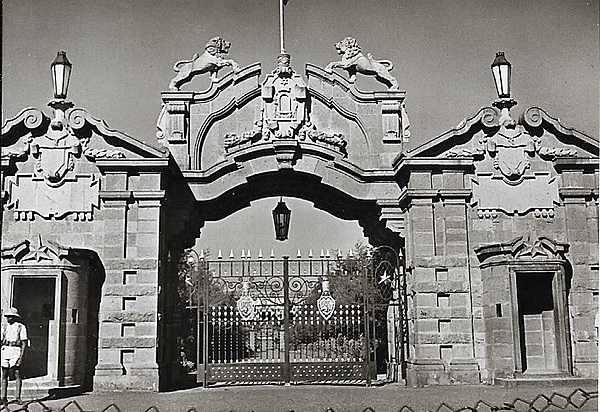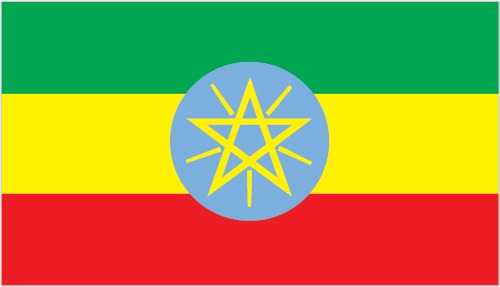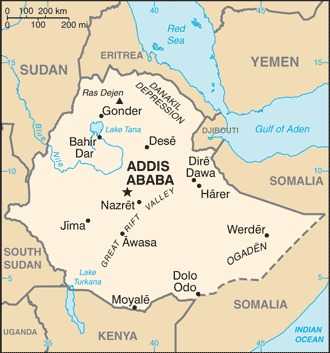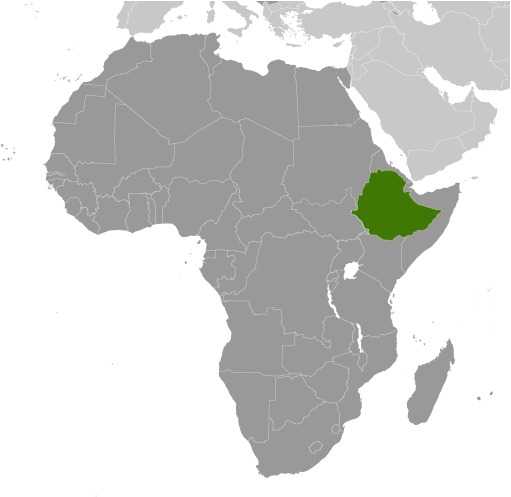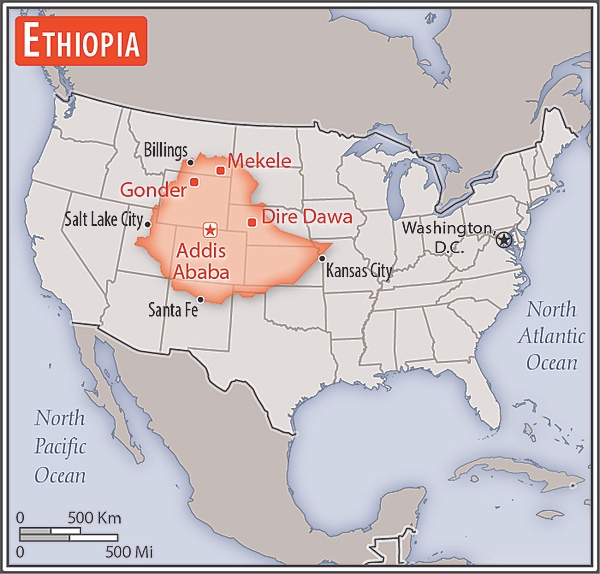Introduction
Background
The area that is modern-day Ethiopia is rich in cultural and religious diversity with more than 80 ethnic groups. The oldest hominid yet found comes from Ethiopia, and Ethiopia was the second country to officially adopt Christianity in the 4th century A.D. A series of monarchies ruled the area that is now Ethiopia from 980 B.C. to 1855, when the Amhara kingdoms of northern Ethiopia united in an empire under Tewodros II. Many Ethiopians still speak reverently about the Battle of Adwa in 1896, when they defeated Italian forces and won their freedom from colonial rule.
Emperor Haile SELASSIE became an internationally renowned figure in 1935, when he unsuccessfully appealed to the League of Nations to prevent Italy from occupying Ethiopia from 1936 to 1941. SELASSIE survived an attempted coup in 1960, annexed modern-day Eritrea in 1962, and played a leading role in establishing the Organization of African Unity in 1963. However, in 1974, a military junta called the Derg deposed him and established a socialist state. Torn by bloody coups, uprisings, drought, and massive displacement, the Derg regime was toppled in 1991 by a coalition of opposing forces, the Ethiopian People's Revolutionary Democratic Front (EPRDF). The EPRDF became an ethno-federalist political coalition that ruled Ethiopia from 1991 until its dissolution in 2019. Ethiopia adopted its constitution in 1994 and held its first multiparty elections in 1995.
A two-and-a-half-year border war with Eritrea in the late 1990s ended with a peace treaty in 2000. Ethiopia subsequently rejected the 2007 Eritrea-Ethiopia Boundary Commission demarcation. This resulted in more than a decade of a tense “no peace, no war” stalemate between the two countries. In 2012, longtime Prime Minister MELES Zenawi died in office and was replaced by his Deputy Prime Minister HAILEMARIAM Desalegn, marking the first peaceful transition of power in decades. Following a wave of popular dissent and anti-government protest that began in 2015, HAILEMARIAM resigned in 2018, and ABIY Ahmed Ali took office the same year as Ethiopia's first ethnic Oromo prime minister. In 2018, ABIY promoted a rapprochement between Ethiopia and Eritrea that was marked with a peace agreement and a reopening of their shared border. In 2019, Ethiopia's nearly 30-year ethnic-based ruling coalition, the EPRDF, merged into a single unity party called the Prosperity Party; however, the lead coalition party, the Tigray People’s Liberation Front (TPLF), declined to join. In 2020, a military conflict erupted between forces aligned with the TPLF and the Ethiopian military. The conflict -- which was marked by atrocities committed by all parties -- ended in 2022 with a cessation of hostilities agreement between the TPLF and the Ethiopian Government. However, Ethiopia continues to experience ethnic-based violence as other groups -- including the Oromo Liberation Army (OLA) and Amhara militia Fano -- seek concessions from the Ethiopian Government.
Visit the Definitions and Notes page to view a description of each topic.
Geography
Location
Eastern Africa, west of Somalia
Geographic coordinates
8 00 N, 38 00 E
Map references
Africa
Area
total : 1,104,300 sq km
land: 1,096,570 sq km
water: 7,730 sq km
note: area numbers are approximate since a large portion of the Ethiopia-Somalia border is undefined
comparison ranking: total 28
Land boundaries
total: 5,925 km
border countries (6): Djibouti 342 km; Eritrea 1,033 km; Kenya 867 km; Somalia 1,640 km; South Sudan 1,299 km; Sudan 744 km
Coastline
0 km (landlocked)
Maritime claims
none (landlocked)
Climate
tropical monsoon with wide topographic-induced variation
Terrain
high plateau with central mountain range divided by Great Rift Valley
Elevation
highest point: Ras Dejen 4,550 m
lowest point: Danakil Depression -125 m
mean elevation: 1,330 m
Natural resources
small reserves of gold, platinum, copper, potash, natural gas, hydropower
Land use
agricultural land: 36.3% (2018 est.)
arable land: 15.2% (2018 est.)
permanent crops: 1.1% (2018 est.)
permanent pasture: 20% (2018 est.)
forest: 12.2% (2018 est.)
other: 51.5% (2018 est.)
Irrigated land
1,813 sq km (2020)
Major lakes (area sq km)
fresh water lake(s): Lake Tana - 3,600 sq km; Abaya Hayk - 1,160 sq km; Ch'amo Hayk - 550 sq km
salt water lake(s): Lake Turkana (shared with Kenya) - 6,400 sq km; Abhe Bid Hayk/Abhe Bad (shared with Djibouti) - 780 sq km;
Major rivers (by length in km)
Blue Nile river source (shared with Sudan [m]) - 1,600 km
note – [s] after country name indicates river source; [m] after country name indicates river mouth
Major watersheds (area sq km)
Atlantic Ocean drainage: (Mediterranean Sea) Nile (3,254,853 sq km)
Major aquifers
Ogaden-Juba Basin, Sudd Basin (Umm Ruwaba Aquifer)
Population distribution
highest density is found in the highlands of the north and middle areas of the country, particularly around the centrally located capital city of Addis Ababa; the far east and southeast are sparsely populated as shown in this population distribution map
Natural hazards
geologically active Great Rift Valley susceptible to earthquakes, volcanic eruptions; frequent droughts
volcanism: volcanic activity in the Great Rift Valley; Erta Ale (613 m), which has caused frequent lava flows in recent years, is the country's most active volcano; Dabbahu became active in 2005, forcing evacuations; other historically active volcanoes include Alayta, Dalaffilla, Dallol, Dama Ali, Fentale, Kone, Manda Hararo, and Manda-Inakir
Geography - note
note 1: landlocked -- entire coastline along the Red Sea was lost with the de jure independence of Eritrea on 24 May 1993; Ethiopia is, therefore, the most populous landlocked country in the world; the Blue Nile, the chief headstream of the Nile by water volume, rises in T'ana Hayk (Lake Tana) in northwest Ethiopia
note 2: three major crops may have originated in Ethiopia: coffee (almost certainly), grain sorghum, and castor bean
People and Society
Population
total: 118,550,298
male: 59,062,093
female: 59,488,205 (2024 est.)
comparison rankings: female 12; male 13; total 12
Nationality
noun: Ethiopian(s)
adjective: Ethiopian
Ethnic groups
Oromo 35.8%, Amhara 24.1%, Somali 7.2%, Tigray 5.7%, Sidama 4.1%, Guragie 2.6%, Welaita 2.3%, Afar 2.2%, Silte 1.3%, Kefficho 1.2%, other 13.5% (2022 est.)
Languages
Oromo (official working language of Oromia Regional State) 33.8%, Amharic (official national language) 29.3%, Somali (official working language of Somali Regional State) 6.2%, Tigrigna (Tigrinya) (official working language of Tigray Regional State) 5.9%, Sidamo 4%, Wolaytta 2.2%, Gurage 2%, Afar (official working language of Afar Regional State) 1.7%, Hadiyya 1.7%, Gamo 1.5%, Gedeo 1.3%, Opuuo 1.2%, Kafa 1.1%, other 8.1%, English
note: Sidama is an official working language of Sidama Regional State (2007 est.)
major-language sample(s):
Kitaaba Addunyaa Waan Qabataamaatiif - Kan Madda Odeeffannoo bu’uraawaatiif baay’ee barbaachisaa ta’e. (Oromo)
የአለም እውነታ መጽሐፍ፣ ለመሠረታዊ መረጃ እጅግ አስፈላጊ የሆነ ምንጭ። (Amharic)
The World Factbook, the indispensable source for basic information.
Religions
Ethiopian Orthodox 43.8%, Muslim 31.3%, Protestant 22.8%, Catholic 0.7%, traditional 0.6%, other 0.8% (2016 est.)
Demographic profile
Ethiopia is a predominantly agricultural country – nearly 80% of the population lives in rural areas – that is in the early stages of demographic transition. Infant, child, and maternal mortality have fallen sharply over the past decade, but the total fertility rate has declined more slowly and the population continues to grow. The rising age of marriage and the increasing proportion of women remaining single have contributed to fertility reduction. While the use of modern contraceptive methods among married women has increased significantly from 6 percent in 2000 to 27 percent in 2012, the overall rate is still quite low.
Ethiopia’s rapid population growth is putting increasing pressure on land resources, expanding environmental degradation, and raising vulnerability to food shortages. With about 40 percent of the population below the age of 15 and a fertility rate of 4 children per woman (and even higher in rural areas), Ethiopia will have to make further progress in meeting its family planning needs if it is to achieve the age structure necessary for reaping a demographic dividend in the coming decades.
Poverty, drought, political repression, and forced government resettlement have driven Ethiopia’s internal and external migration since the 1960s. Before the 1974 revolution, only small numbers of the Ethiopian elite went abroad to study and then returned home, but under the brutal Derg regime thousands fled the country, primarily as refugees. Between 1982 and 1991 there was a new wave of migration to the West for family reunification. Since the defeat of the Derg in 1991, Ethiopians have migrated to escape violence among some of the country’s myriad ethnic groups or to pursue economic opportunities. Internal and international trafficking of women and children for domestic work and prostitution is a growing problem.
Age structure
0-14 years: 38.7% (male 23,092,496/female 22,765,882)
15-64 years: 58% (male 34,175,328/female 34,536,238)
65 years and over: 3.4% (2024 est.) (male 1,794,269/female 2,186,085)
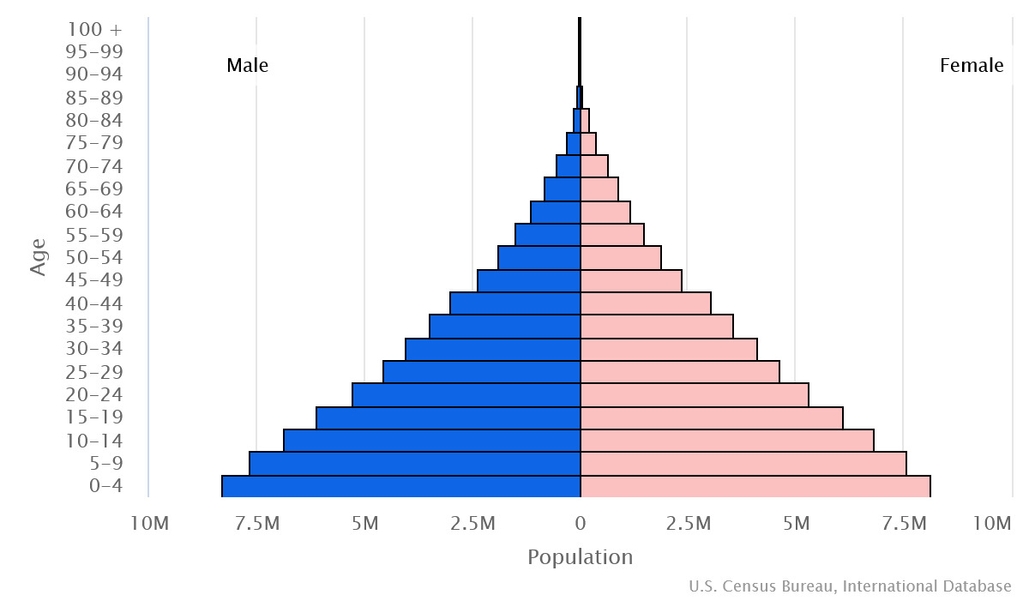
Dependency ratios
total dependency ratio: 75.7
youth dependency ratio: 70.2
elderly dependency ratio: 5.5
potential support ratio: 18.1 (2021 est.)
Median age
total: 20.4 years (2024 est.)
male: 20.2 years
female: 20.7 years
comparison ranking: total 203
Population distribution
highest density is found in the highlands of the north and middle areas of the country, particularly around the centrally located capital city of Addis Ababa; the far east and southeast are sparsely populated as shown in this population distribution map
Urbanization
urban population: 23.2% of total population (2023)
rate of urbanization: 4.4% annual rate of change (2020-25 est.)
Major urban areas - population
5.461 million ADDIS ABABA (capital) (2023)
Sex ratio
at birth: 1.03 male(s)/female
0-14 years: 1.01 male(s)/female
15-64 years: 0.99 male(s)/female
65 years and over: 0.82 male(s)/female
total population: 0.99 male(s)/female (2024 est.)
Mother's mean age at first birth
19.3 years (2019 est.)
note: data represents median age at first birth among women 20-49
Infant mortality rate
total: 32.6 deaths/1,000 live births (2024 est.)
male: 37.4 deaths/1,000 live births
female: 27.6 deaths/1,000 live births
comparison ranking: total 40
Life expectancy at birth
total population: 67.7 years (2024 est.)
male: 65.4 years
female: 70 years
comparison ranking: total population 196
Gross reproduction rate
1.89 (2024 est.)
Contraceptive prevalence rate
37.7% (2020)
Drinking water source
improved: urban: 98.5% of population
rural: 70.2% of population
total: 76.4% of population
unimproved: urban: 1.5% of population
rural: 29.8% of population
total: 23.6% of population (2020 est.)
Current health expenditure
3.5% of GDP (2020)
Physician density
0.11 physicians/1,000 population (2020)
Hospital bed density
0.3 beds/1,000 population (2016)
Sanitation facility access
improved: urban: 52.5% of population
rural: 8.1% of population
total: 17.7% of population
unimproved: urban: 47.5% of population
rural: 91.9% of population
total: 82.3% of population (2020 est.)
Major infectious diseases
degree of risk: very high (2023)
food or waterborne diseases: bacterial and protozoal diarrhea, hepatitis A, and typhoid fever
vectorborne diseases: malaria and dengue fever
water contact diseases: schistosomiasis
animal contact diseases: rabies
respiratory diseases: meningococcal meningitis
Alcohol consumption per capita
total: 1.16 liters of pure alcohol (2019 est.)
beer: 0.92 liters of pure alcohol (2019 est.)
wine: 0 liters of pure alcohol (2019 est.)
spirits: 0.2 liters of pure alcohol (2019 est.)
other alcohols: 0.03 liters of pure alcohol (2019 est.)
comparison ranking: total 149
Tobacco use
total: 5.1% (2020 est.)
male: 8.8% (2020 est.)
female: 1.3% (2020 est.)
comparison ranking: total 161
Currently married women (ages 15-49)
67.5% (2023 est.)
Child marriage
women married by age 15: 14.1%
women married by age 18: 40.3%
men married by age 18: 5% (2016 est.)
Literacy
definition: age 15 and over can read and write
total population: 51.8%
male: 57.2%
female: 44.4% (2017)
School life expectancy (primary to tertiary education)
total: 9 years
male: 8 years
female: 8 years (2012)
Environment
Environment - current issues
deforestation; overgrazing; soil erosion; desertification; loss of biodiversity; water shortages in some areas from water-intensive farming and poor management; industrial pollution and pesticides contribute to air, water, and soil pollution
Environment - international agreements
party to: Biodiversity, Climate Change, Climate Change-Kyoto Protocol, Climate Change-Paris Agreement, Comprehensive Nuclear Test Ban, Desertification, Endangered Species, Hazardous Wastes, Ozone Layer Protection
signed, but not ratified: Environmental Modification, Law of the Sea, Nuclear Test Ban
Climate
tropical monsoon with wide topographic-induced variation
Land use
agricultural land: 36.3% (2018 est.)
arable land: 15.2% (2018 est.)
permanent crops: 1.1% (2018 est.)
permanent pasture: 20% (2018 est.)
forest: 12.2% (2018 est.)
other: 51.5% (2018 est.)
Urbanization
urban population: 23.2% of total population (2023)
rate of urbanization: 4.4% annual rate of change (2020-25 est.)
Food insecurity
widespread lack of access: due to conflict in Tigray Region, drought conditions in southeastern areas, high food prices - The difficult and worsening food security situation is the result of multiple shocks affecting food availability and access including: the conflict in northern Tigray Region and in adjacent areas of Amhara and Afar regions, which began in November 2020; in Tigray region alone, 5.3 million people are estimated to be severely food insecure; the failure of the March‑May 2022 “Gu‑Genna” rains in southern pastoral areas of southern Oromiya Region and southern Somali Region, exacerbated drought conditions prevailing since late 2020, causing severe crop and livestock losses; severe macroeconomic challenges including insufficient foreign currency reserves and the continuous depreciation of the national currency, as a result, inflation is at very high levels, with the year‑on‑year food inflation rate estimated at 35.5 percent in July, one the highest of the last decade; these difficulties are exacerbated by the ripple effects of the Ukraine war, which triggered hikes in international prices of wheat, fuel, and fertilizers (2023)
Air pollutants
particulate matter emissions: 21.8 micrograms per cubic meter (2019 est.)
carbon dioxide emissions: 14.87 megatons (2016 est.)
methane emissions: 114.21 megatons (2020 est.)
Waste and recycling
municipal solid waste generated annually: 6,532,787 tons (2015 est.)
Major lakes (area sq km)
fresh water lake(s): Lake Tana - 3,600 sq km; Abaya Hayk - 1,160 sq km; Ch'amo Hayk - 550 sq km
salt water lake(s): Lake Turkana (shared with Kenya) - 6,400 sq km; Abhe Bid Hayk/Abhe Bad (shared with Djibouti) - 780 sq km;
Major rivers (by length in km)
Blue Nile river source (shared with Sudan [m]) - 1,600 km
note – [s] after country name indicates river source; [m] after country name indicates river mouth
Major watersheds (area sq km)
Atlantic Ocean drainage: (Mediterranean Sea) Nile (3,254,853 sq km)
Major aquifers
Ogaden-Juba Basin, Sudd Basin (Umm Ruwaba Aquifer)
Total water withdrawal
municipal: 810 million cubic meters (2020 est.)
industrial: 50 million cubic meters (2020 est.)
agricultural: 9.69 billion cubic meters (2020 est.)
Total renewable water resources
122 billion cubic meters (2020 est.)
Government
Country name
conventional long form: Federal Democratic Republic of Ethiopia
conventional short form: Ethiopia
local long form: YeItyop'iya Federalawi Demokrasiyawi Ripeblik
local short form: Ityop'iya
former: Abyssinia, Italian East Africa
abbreviation: FDRE
etymology: the country name derives from the Greek word "Aethiopia," which in classical times referred to lands south of Egypt in the Upper Nile region
Government type
federal parliamentary republic
Capital
name: Addis Ababa
geographic coordinates: 9 02 N, 38 42 E
time difference: UTC+3 (8 hours ahead of Washington, DC, during Standard Time)
etymology: the name in Amharic means "new flower" and was bestowed on the city in 1889, three years after its founding
Administrative divisions
12 ethnically based regional states (kililoch, singular - kilil) and 2 chartered cities* (astedader akabibiwach, singular - astedader akabibi); Adis Abeba* (Addis Ababa), Afar, Amara (Amhara), Binshangul Gumuz, Dire Dawa*, Gambela Hizboch (Gambela), Hareri Hizb (Harari), Oromia, Sidama, Sumale, Tigray, YeDebub Biheroch Bihereseboch na Hizboch (Southern Nations, Nationalities and Peoples), YeDebub M'irab Ityop'iya Hizboch (Southwest Ethiopia Peoples), Southern Ethiopia Peoples
Independence
oldest independent country in Africa and one of the oldest in the world - at least 2,000 years (may be traced to the Aksumite Kingdom, which coalesced in the first century B.C.)
National holiday
Derg Downfall Day (defeat of MENGISTU regime), 28 May (1991)
Constitution
history: several previous; latest drafted June 1994, adopted 8 December 1994, entered into force 21 August 1995
amendments: proposals submitted for discussion require two-thirds majority approval in either house of Parliament or majority approval of one-third of the State Councils; passage of amendments other than constitutional articles on fundamental rights and freedoms and the initiation and amendment of the constitution requires two-thirds majority vote in a joint session of Parliament and majority vote by two thirds of the State Councils; passage of amendments affecting rights and freedoms and amendment procedures requires two-thirds majority vote in each house of Parliament and majority vote by all the State Councils
Legal system
civil law system
International law organization participation
has not submitted an ICJ jurisdiction declaration; non-party state to the ICCt
Citizenship
citizenship by birth: no
citizenship by descent only: at least one parent must be a citizen of Ethiopia
dual citizenship recognized: no
residency requirement for naturalization: 4 years
Suffrage
18 years of age; universal
Executive branch
chief of state: President SAHLE-WORK Zewde (since 25 October 2018)
head of government: Prime Minister ABIY Ahmed Ali (since April 2018)
cabinet: Council of Ministers selected by the prime minister and approved by the House of People's Representatives
elections/appointments: president indirectly elected by both chambers of Parliament for a 6-year term (eligible for a second term); election held on 21 June 2021 and 30 September 2021 (the scheduled 29 August 2020 election was postponed by Prime Minister ABIY due to the COVID-19 pandemic); prime minister designated by the majority party following legislative elections
election results:
2021: SAHLE-WORK Zewde reelected president during joint session of Parliament, vote - 659 (unanimous); ABIY confirmed Prime Minister by House of Peoples' Representatives (4 October 2021)
2018: SAHLE-WORK Zewde elected president during joint session of Parliament, vote - 659 (unanimous); note - snap election held on 25 October 2018 due to resignation of President MULATA Teshome
note: SAHLE-WORK Zewde is the first female elected head of state in Ethiopia
Legislative branch
description: bicameral Parliament consists of:
House of Federation or Yefedereshein Mikir Bete (153 seats maximum; 144 seats current; members indirectly elected by state assemblies to serve 5-year terms)
House of People's Representatives or Yehizb Tewokayoch Mekir Bete (547 seats maximum; 470 seats current; members directly elected in single-seat constituencies by simple majority vote; 22 seats reserved for minorities; all members serve 5-year terms)
elections: House of Federation - last held 4 October 2021 (next expected in October 2026)
House of People's Representatives - last held in two parts on 21 June 2021 and 30 September 2021 (next expected in June 2026)
election results: House of Federation - percent of vote by party/coalition - NA; seats by party/coalition - NA; composition - men 102, women 43, percentage women 29.7%
House of Representatives - percent of vote by party/coalition - NA; seats by party/coalition - Prosperity Party 454, NAMA 5, EZEMA 4, Gedeo People's Democratic organization 2, Kucha People Democratic Party 1, independent 4; composition - men 275, women 195, percentage women 41.3%; note - total Parliament percentage women 38.9%
notes: House of Federation is responsible for interpreting the constitution and federal-regional issues and the House of People's Representatives is responsible for passing legislation; percent of vote percentages are calculated on the number of members actually seated versus on the constitutional maximums
Judicial branch
highest court(s): Federal Supreme Court (consists of 11 judges); note - the House of Federation has jurisdiction for all constitutional issues
judge selection and term of office: president and vice president of Federal Supreme Court recommended by the prime minister and appointed by the House of People's Representatives; other Supreme Court judges nominated by the Federal Judicial Administrative Council (a 10-member body chaired by the president of the Federal Supreme Court) and appointed by the House of People's Representatives; judges serve until retirement at age 60
subordinate courts: federal high courts and federal courts of first instance; state court systems (mirror structure of federal system); sharia courts and customary and traditional courts
Political parties and leaders
House of People's Representatives:
Ethiopian Citizens for Social Justice and Democracy or EZEMA [BERHANU Nega]
Gedeo People's Democratic Party
Independent [n/a]
Kucha People Democratic Party
National Movement of Amhara or NAMA [BELETE Molla]
Prosperity Party or PP [ABIY Ahmed Ali]
International organization participation
ACP, AfDB, ATMIS, AU, BRICS, COMESA, EITI, FAO, G-24, G-77, IAEA, IBRD, ICAO, ICRM, IDA, IFAD, IFC, IFRCS, IGAD, ILO, IMF, IMO, Interpol, IOC, IOM, IPU, ISO, ITSO, ITU, ITUC (NGOs), MIGA, NAM, OPCW, PCA, UN, UNCTAD, UNESCO, UNHCR, UNIDO, UNMISS, UNOOSA, UNWTO, UPU, WCO, WFTU (NGOs), WHO, WIPO, WMO, WTO (accession candidate)
Diplomatic representation in the US
chief of mission: Ambassador SELESHI Bekele Awulachew (since 7 June 2022)
chancery: 3506 International Drive NW, Washington, DC 20008
telephone: [1] (202) 364-1200
FAX: [1] (202) 587-0195
email address and website:
ethiopia@ethiopianembassy.org
https://ethiopianembassy.org/
consulate(s) general: Los Angeles, St. Paul (MN)
Diplomatic representation from the US
chief of mission: Ambassador Ervin MASSINGA (since 4 October 2023)
embassy: Entoto Street, P.O. Box 1014, Addis Ababa
mailing address: 2030 Addis Ababa Place, Washington DC 20521-2030
telephone: [251] 111-30-60-00
FAX: [251] 111-24-24-01
email address and website:
AddisACS@state.gov
https://et.usembassy.gov/
Flag description
three equal horizontal bands of green (top), yellow, and red, with a yellow pentagram and single yellow rays emanating from the angles between the points on a light blue disk centered on the three bands; green represents hope and the fertility of the land, yellow symbolizes justice and harmony, while red stands for sacrifice and heroism in the defense of the land; the blue of the disk symbolizes peace and the pentagram represents the unity and equality of the nationalities and peoples of Ethiopia
note: Ethiopia is the oldest independent country in Africa, and the three main colors of her flag (adopted ca. 1895) were so often appropriated by other African countries upon independence that they became known as the Pan-African colors; the emblem in the center of the current flag was added in 1996
National symbol(s)
Abyssinian lion (traditional), yellow pentagram with five rays of light on a blue field (promoted by current government); national colors: green, yellow, red
National anthem
name: "Whedefit Gesgeshi Woud Enat Ethiopia" (March Forward, Dear Mother Ethiopia)
lyrics/music: DEREJE Melaku Mengesha/SOLOMON Lulu
note: adopted 1992
National heritage
total World Heritage Sites: 11 (9 cultural, 2 natural)
selected World Heritage Site locales: Rock-Hewn Churches, Lalibela (c); Simien National Park (n); Fasil Ghebbi, Gondar Region (c); Axum (c); Lower Valley of the Awash (c); Lower Valley of the Omo (c); Tiya (c); Harar Jugol, the Fortified Historic Town (c); Konso Cultural Landscape (c); Gedeo Cultural Landscape (c)
Economy
Economic overview
growing Horn of Africa construction- and services-based economy; port access via Djibouti and Eritrea; widespread but declining poverty; COVID-19, locust invasion, and Tigray crisis disruptions; public investment increases; second largest African labor force
Real GDP (purchasing power parity)
$354.604 billion (2023 est.)
$332.968 billion (2022 est.)
$316.145 billion (2021 est.)
note: data in 2021 dollars
comparison ranking: 56
Real GDP growth rate
6.5% (2023 est.)
5.32% (2022 est.)
5.64% (2021 est.)
note: annual GDP % growth based on constant local currency
comparison ranking: 25
Real GDP per capita
$2,800 (2023 est.)
$2,700 (2022 est.)
$2,600 (2021 est.)
note: data in 2021 dollars
comparison ranking: 200
GDP (official exchange rate)
$163.698 billion (2023 est.)
note: data in current dollars at official exchange rate
Inflation rate (consumer prices)
30.22% (2023 est.)
33.89% (2022 est.)
26.84% (2021 est.)
note: annual % change based on consumer prices
comparison ranking: 207
Credit ratings
Fitch rating: B (2014)
Moody's rating: B2 (2020)
Standard & Poors rating: B (2014)
note: The year refers to the year in which the current credit rating was first obtained.
GDP - composition, by sector of origin
agriculture: 34.8% (2017 est.)
industry: 21.6% (2017 est.)
services: 43.6% (2017 est.)
comparison rankings: services 200; industry 134; agriculture 12
GDP - composition, by end use
household consumption: 69.6% (2017 est.)
government consumption: 10% (2017 est.)
investment in fixed capital: 43.5% (2017 est.)
investment in inventories: -0.1% (2017 est.)
exports of goods and services: 8.1% (2017 est.)
imports of goods and services: -31.2% (2017 est.)
Agricultural products
maize, wheat, cereals, sorghum, milk, barley, taro, potatoes, millet, beans (2022)
note: top ten agricultural products based on tonnage
Industries
food processing, beverages, textiles, leather, garments, chemicals, metals processing, cement
Industrial production growth rate
6.93% (2023 est.)
note: annual % change in industrial value added based on constant local currency
comparison ranking: 34
Labor force
61.664 million (2023 est.)
note: number of people ages 15 or older who are employed or seeking work
comparison ranking: 11
Unemployment rate
3.5% (2023 est.)
3.49% (2022 est.)
3.94% (2021 est.)
note: % of labor force seeking employment
comparison ranking: 62
Youth unemployment rate (ages 15-24)
total: 5.7% (2021 est.)
male: 4.4%
female: 7.2%
comparison ranking: total 183
Population below poverty line
23.5% (2015 est.)
note: % of population with income below national poverty line
Gini Index coefficient - distribution of family income
35 (2015 est.)
note: index (0-100) of income distribution; higher values represent greater inequality
comparison ranking: 93
Average household expenditures
on food: 41.3% of household expenditures (2021 est.)
on alcohol and tobacco: 3.1% of household expenditures (2021 est.)
Household income or consumption by percentage share
lowest 10%: 2.9% (2015 est.)
highest 10%: 28.5% (2015 est.)
note: % share of income accruing to lowest and highest 10% of population
Remittances
0.36% of GDP (2023 est.)
0.4% of GDP (2022 est.)
0.4% of GDP (2021 est.)
note: personal transfers and compensation between resident and non-resident individuals/households/entities
Budget
revenues: $11.308 billion (2020 est.)
expenditures: $13.979 billion (2020 est.)
Public debt
31.45% of GDP (2019 est.)
32.53% of GDP (2018 est.)
30.1% of GDP (2017 est.)
note: central government debt as a % of GDP
comparison ranking: 167
Taxes and other revenues
4.51% (of GDP) (2022 est.)
note: central government tax revenue as a % of GDP
comparison ranking: 208
Current account balance
-$4.788 billion (2023 est.)
-$5.16 billion (2022 est.)
-$4.507 billion (2021 est.)
note: balance of payments - net trade and primary/secondary income in current dollars
comparison ranking: 181
Exports
$10.865 billion (2023 est.)
$10.971 billion (2022 est.)
$9.496 billion (2021 est.)
note: balance of payments - exports of goods and services in current dollars
comparison ranking: 112
Exports - partners
UAE 17%, US 13%, Germany 6%, Saudi Arabia 6%, Somalia 6% (2022)
note: top five export partners based on percentage share of exports
Exports - commodities
coffee, gold, garments, cut flowers, vegetables (2022)
note: top five export commodities based on value in dollars
Imports
$22.951 billion (2023 est.)
$24.187 billion (2022 est.)
$20.859 billion (2021 est.)
note: balance of payments - imports of goods and services in current dollars
comparison ranking: 92
Imports - partners
China 24%, US 9%, India 8%, UAE 6%, UK 4% (2022)
note: top five import partners based on percentage share of imports
Imports - commodities
wheat, refined petroleum, fertilizers, vaccines, palm oil (2022)
note: top five import commodities based on value in dollars
Reserves of foreign exchange and gold
$3.046 billion (2020 est.)
$2.993 billion (2019 est.)
$3.987 billion (2018 est.)
note: holdings of gold (year-end prices)/foreign exchange/special drawing rights in current dollars
comparison ranking: 115
Exchange rates
birr (ETB) per US dollar -
Exchange rates:
54.601 (2023 est.)
51.756 (2022 est.)
43.734 (2021 est.)
34.927 (2020 est.)
29.07 (2019 est.)
Energy
Electricity access
electrification - total population: 55% (2022 est.)
electrification - urban areas: 94%
electrification - rural areas: 43%
Electricity
installed generating capacity: 5.73 million kW (2022 est.)
consumption: 10.596 billion kWh (2022 est.)
exports: 1.665 billion kWh (2022 est.)
transmission/distribution losses: 3.154 billion kWh (2022 est.)
comparison rankings: transmission/distribution losses 142; exports 59; consumption 101; installed generating capacity 83
Electricity generation sources
solar: 0.2% of total installed capacity (2022 est.)
wind: 3.8% of total installed capacity (2022 est.)
hydroelectricity: 95.7% of total installed capacity (2022 est.)
biomass and waste: 0.2% of total installed capacity (2022 est.)
Coal
production: 8,000 metric tons (2022 est.)
consumption: 660,000 metric tons (2022 est.)
exports: 1,000 metric tons (2022 est.)
imports: 666,000 metric tons (2022 est.)
Petroleum
refined petroleum consumption: 110,000 bbl/day (2022 est.)
crude oil estimated reserves: 428,000 barrels (2021 est.)
Natural gas
proven reserves: 24.919 billion cubic meters (2021 est.)
Carbon dioxide emissions
17.232 million metric tonnes of CO2 (2022 est.)
from coal and metallurgical coke: 1.38 million metric tonnes of CO2 (2022 est.)
from petroleum and other liquids: 15.852 million metric tonnes of CO2 (2022 est.)
comparison ranking: total emissions 92
Communications
Telephones - fixed lines
total subscriptions: 862,000 (2022 est.)
subscriptions per 100 inhabitants: (2022 est.) less than 1
comparison ranking: total subscriptions 75
Telephones - mobile cellular
total subscriptions: 69.123 million (2022 est.)
subscriptions per 100 inhabitants: 56 (2022 est.)
comparison ranking: total subscriptions 25
Telecommunication systems
general assessment: Ethio telecom is the major provider, but no longer has a complete monopoly on all telecom services; a consortium led by Kenyan Safaricom launched service in October 2022; the World Bank in early 2021 provided a $200 million loan to help develop the country’s digital transformation, while the government has embarked on its 2020-2030 program as well as its Digital Ethiopia 2025 strategy, both aimed at making better use of digital technologies to promote socioeconomic development (2023)
domestic: fixed-line subscriptions less than 1 per 100 while mobile-cellular stands at a little over 54 per 100 people (2021)
international: country code - 251; open-wire to Sudan and Djibouti; microwave radio relay to Kenya and Djibouti; 2 domestic satellites provide the national trunk service; satellite earth stations - 3 Intelsat (1 Atlantic Ocean and 2 Pacific Ocean) (2016)
Broadcast media
10 public/state broadcasters; 9 public/state radio stations; 13 commercial FM radio stations; 18 commercial TV stations; 45 community radio stations; 5 community TV stations (2023)
Internet users
total: 20.4 million (2021 est.)
percent of population: 17% (2021 est.)
comparison ranking: total 44
Broadband - fixed subscriptions
total: 212,000 (2020 est.)
subscriptions per 100 inhabitants: 0.2 (2020 est.)
comparison ranking: total 118
Transportation
National air transport system
number of registered air carriers: 1 (2020)
inventory of registered aircraft operated by air carriers: 75
annual passenger traffic on registered air carriers: 11,501,244 (2018)
annual freight traffic on registered air carriers: 2,089,280,000 (2018) mt-km
Heliports
1 (2024)
Military and Security
Military and security forces
Ethiopian National Defense Force (ENDF): Ground Forces, Ethiopian Air Force (Ye Ityopya Ayer Hayl, ETAF) (2023)
note 1: national and regional police forces are responsible for law enforcement and maintenance of order, with the ENDF sometimes providing internal security support; the Ethiopian Federal Police (EFP) report to the Prime Minister’s Office
note 2: the regional governments control regional security forces, including "special" paramilitary forces, which generally operate independently from the federal government and in some cases operate as regional defense forces maintaining national borders; local militias also operate across the country in loose and varying coordination with these regional security and police forces, the ENDF, and the EFP; in April 2023, the federal government ordered the integration of these regional special forces into the EFP or ENDF; in some cases, the regional governments have maintained former members of the special forces for “crowd control/Adma Bitena” as a separate unit within their security structures
note 3: in 2020 the Ethiopian Government announced it had re-established a navy, which had been disbanded in 1996; in March 2019, Ethiopia signed a defense cooperation agreement with France which stipulated that France would support the establishment of an Ethiopian navy, which would reportedly be based out of Djibouti; in 2018, Ethiopia established a Republican Guard military unit responsible to the Prime Minister for protecting senior officials
Military expenditures
1% of GDP (2023 est.)
1.7% of GDP (2022 est.)
0.5% of GDP (2021 est.)
0.5% of GDP (2020 est.)
0.6% of GDP (2019 est.)
comparison ranking: 128
Military and security service personnel strengths
information varies; prior to the 2020-2022 Tigray conflict, approximately 150,000 active-duty troops (2023)
Military equipment inventories and acquisitions
the ENDF's inventory is comprised mostly of Russian and Soviet-era equipment; in recent years, the ENDF has received arms from a variety of countries, including China, Israel, Russia, Turkey, Ukraine, and the United Arab Emirates; Ethiopia has a modest industrial defense base centered on small arms and production of armored vehicles (2023)
Military service age and obligation
18-22 years of age for voluntary military service (although the military may, when necessary, recruit a person more than 22 years old); no compulsory military service, but the military can conduct callups when necessary and compliance is compulsory (2023)
Military deployments
approximately 5-8,000 in Somalia (approximately 3,000 for ATMIS; the remainder under a bilateral agreement with the Somali Government; note - foreign troop contingents in Somalia under ATMIS are drawing down towards a final departure in December 2024); 1,500 South Sudan (UNMISS) (2024)
Military - note
the ENDF is focused on both external threats emanating from its neighbors and internal threats from multiple internal armed groups; since 1998, the ENDF has engaged in several conventional and counterinsurgency operations, including border wars with Eritrea (1998-2000) and Somalia (2006-2008) and internal conflicts with the Tigray regional state (2020-2022), several insurgent groups and ethnic militias (including the ethnonationalist Amhara Fano), and the al-Shabaab terrorist group (see Appendix T); as of 2024, the ENDF was conducting counterinsurgency operations against anti-government militants in several states, including in Oromya (Oromia) against the Oromo Liberation Army (OLA), an insurgent group that claims to be fighting for greater autonomy for the Oromo, Ethiopia's largest ethnic group; in 2022, militants from the Somalia-based al-Shabaab terrorist group launched an incursion into Ethiopia's Somali (Sumale) regional state, attacking villages and security forces; the Ethiopian Government claimed that regional security forces killed hundreds of al-Shabaab fighters and subsequently deployed additional ENDF troops into Somalia’s Gedo region to prevent further incursions (2024)
Space
Space agency/agencies
Ethiopian Space Science and Geospatial Institute (ESSGI; formed in 2022 from the joining of the Ethiopian Space Science and Technology Institute or ESSTI and the Ethiopian Geospatial Information Institute or EGII) (2024)
Space program overview
has a small space program with a focus on acquiring and operating satellites, as well as research and astronomy; jointly builds satellites with foreign partners and operates and exploits remote sensing (RS) satellites; developing the ability to manufacture satellites and their associated payloads; involved in astronomy and in the construction of space observatories; cooperates on space-related issues with a variety of countries, including China, France, India, Russia, and multiple African countries, particularly Kenya, Rwanda, Sudan, Tanzania, and Uganda; shares RS data with neighboring countries (2024)
note: further details about the key activities, programs, and milestones of the country’s space program, as well as government spending estimates on the space sector, appear in the Space Programs reference guide
Terrorism
Terrorist group(s)
Terrorist group(s): al-Shabaab; Islamic Revolutionary Guard Corps (IRGC)/Qods Force
note: details about the history, aims, leadership, organization, areas of operation, tactics, targets, weapons, size, and sources of support of the group(s) appear(s) in the Terrorism reference guide
Transnational Issues
Refugees and internally displaced persons
refugees (country of origin): 167,391 (Eritrea) (2023); 420,502 (South Sudan), 314,976 (Somalia), 111,778 (Sudan) (refugees since 15 April 2023) (2024)
IDPs: 4.385 million (includes conflict- and climate-induced IDPs, excluding unverified estimates from the Amhara region; border war with Eritrea from 1998-2000; ethnic clashes; and ongoing fighting between the Ethiopian military and separatist rebel groups in the Somali and Oromia regions; natural disasters; intercommunal violence; most IDPs live in Sumale state) (2023)
Illicit drugs
transit hub for heroin originating in Southwest and Southeast Asia and destined for Europe, as well as cocaine destined for markets in southern Africa; cultivates qat (khat) for local use and regional export, principally to Djibouti and Somalia (legal in all three countries); the lack of a well-developed financial system limits the country's utility as a money laundering center
